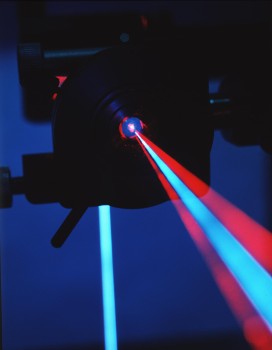In this experiment, entangled
pairs of photons are generated which pass through two independently adjustable polarisation filters. When such a filter is aligned with the polarisation direction of a photon, the photon is let through and registered by the detector. When the filter is perpendicular to the polarisation direction, the photon is absorbed.
If the two filters are perpendicular to each other, every time one detector registers a photon, something is also detected by the other one. This means that the polarisations of the two photons are always perpendicular to each other. On the other hand, according to quantum mechanics neither of the two photons has a specific polarisation direction. This state is called entanglement.
However, when a measurement is carried out on one photon, not only this photon, but also the other one has an unequivocal polarisation. This leads to a dilemma: either we assume that a measurement of one photon can change the state of the other photon by some kind of spooky long-distance effect,
irrespective of how far away it is, or we believe Einstein who says that the photon already had a polarisation – but this means that quantum mechanics is incomplete.
 Scene
Scene


 1st Slide
1st Slide
 Branching Point
Branching Point
 Module: Quantentheorie: EPR-Paradoxon
Module: Quantentheorie: EPR-Paradoxon Sequence: 0.0. Start_Quantentheorie_EPR
Sequence: 0.0. Start_Quantentheorie_EPR Branching Point: Paradoxes of Quantum Mechanics
Branching Point: Paradoxes of Quantum Mechanics Slide: The Layout of the Experiment
Slide: The Layout of the Experiment Back
Back


